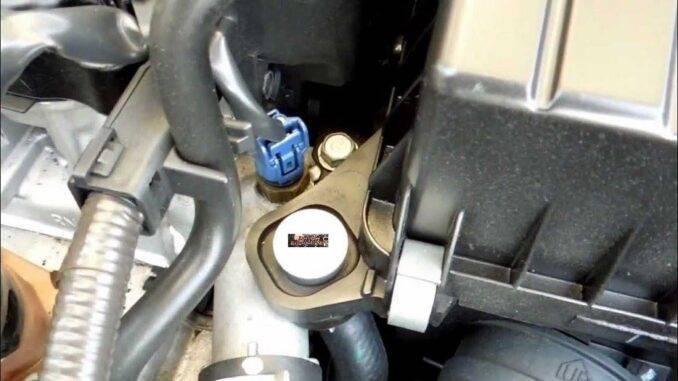
The engine coolant temperature (ECT) sensors function, is to monitor the temperature of the engine’s coolant.
So, most engine coolant temperature (ECT) sensors operate, using electrical resistance to measure the temperature of the coolant.
The readings from the engine coolant temperature (ECT) sensor, are then sent back to the engine control unit (ECU).
The engine coolant temperature (ECT) sensor, is one of the most important, engine management sensors. Because, its readings, play a key role in calculations, which affect engine performance. As a result, the (ECU) uses this data, to adjust, the fuel injection and ignition timing.
Sensor Failure and Warning Signs
So, engines require, more fuel when they are cold. But, less fuel, when they are fully warmed up. The most common symptom that indicates a bad (ECT) sensor. Most often, is an engine control system that fails to go into closed loop, once the engine is warm.
Other Signs Of Failure Include:
- Poor fuel economy.
- Black smoke is coming from the exhaust.
- Overheating engine.
- The check engine light (CEL) comes on.
Possible Engine Codes and Warning Lights
The (OBD II) system, should catch the fault, and turn on the check engine light (CEL) or (MIL) lamp.
Also, You May See One Of The Following, Diagnostic Trouble Codes:
- P0115….Engine Coolant Temperature Circuit.
- P0116….Engine Coolant Temperature Circuit Range/Performance.
- P0117….Engine Coolant Temperature Circuit Low Input.
- P0118….Engine Coolant Temperature Circuit High Input.
- P0119….Engine Coolant Temperature Circuit Intermittent.
The (PCM) Uses Inputs From the (ECT) Sensor to Control Functions:
Start Up Fuel Enrichment, On Fuel Injected Engines
If the (PCM) receives a cold signal from the (ECT) sensor. Then, it increases injector pulse width (on time), to create a richer fuel mixture. This improves idle quality and prevents hesitation, while the cold engine is warming up. But, as the engine nears normal operating temperature. Then, the (PCM) leans out the fuel mixture, to reduce emissions and fuel consumption.
So, a faulty (ECT) sensor that always reads cold, may cause the fuel control system to run rich. Consequently, polluting air and waste fuel. Also, a (ECT) sensor that always reads hot, may cause cold driveability problems. Including, stalling, hesitation and rough idle.
Spark Advance And Retarding
So, spark advance, is often limited for emission purposes, until the engine reaches, normal operating temperature. And, this also affects engine performance, and fuel economy.
Exhaust Gas Recirculation (EGR) Valve, During Engine Warm-up
The (PCM) will not allow the (EGR) valve to open until the engine has warmed up, to improve driveability. But, if the (EGR) is allowed, with a cold engine. Then, it may cause a rough idle, stalling and/or hesitation.
An open thermostat or the wrong thermostat, may be stopping the coolant from reaching its normal operating temperature.
Evaporative Emissions Control (EVAP) Canister Purge
Fuel vapors stored in the charcoal canister, are not purged until the engine is warm. In addition, to prevent drivability problems.
Open/Closed Loop Feedback Control Of The Air/Fuel Mixture
The (PCM) may ignore the (O2) sensor rich/lean feedback signal, until the coolant reaches a certain temperature. While the engine is cold, the (PCM) will remain in “open loop”. And, keep the fuel mixture rich, to improve idle quality and cold driveability.
But, if the (PCM) fails to go into “closed loop”. Then, once the engine is warm, the fuel mixture will be, too rich causing, pollution and fuel waste. As a result, this condition, may also lead to spark plug fouling.
Idle Speed During Engine Warm-up
The (PCM) will usually, increase idle speed when a cold engine is first started. Consequently, to prevent stalling and improve idle quality.
Transmission Torque Converter Clutch Lockup, During Engine Warm-up
The (PCM) may not lockup up the torque converter, until the engine has warmed up, to improve cold driveability.
Operation Of The Electric Engine Cooling Fan
The (PCM) will cycle the cooling fan on and off, to control engine cooling. Subsequently, using input from the (ECT) sensor. That’s why, its job is extremely important, in stopping engine overheating.
Keep in mind that many (ECT) sensor problems, are often, due to wiring faults and loose or corroded connectors. And, is usually not a failure of the sensor itself. That’s why, a visual inspection of the (ECT) sensor, will sometimes reveal a problem.
This could be, severe corrosion around the terminal, a crack in the sensor or coolant leaks around the sensor. So, in most cases the only way to know if the (ECT) sensor is good or bad. Is to measure its resistance and voltage readings.
Engine Coolant Temperature (ECT) Testing
So, the first thing to check, is the (ECT) sensor wiring harness. (Using A Multimeter) This allows you to check, if the harness that receives the signals, is having a problem. Because, it might not be relaying the signal to the computer.
To Will Rule Out Any Faulty Wiring:
- Pull out the harness connected to the sensor, to reveal the connection point, between the harness and the sensor.
- Turn the ignition key on, without starting the engine.
- Connect the red clip to terminal two, while grounding the black clip.
Finally, if the Multimeter reads at most 5 volts, then the harness has no problem.
Ohmmeter Testing:
- Start with a cold engine.
- With the ignition off, disconnect the wiring connector, from the (ECT) sensor.
- Attach an ohmmeter, across the sensor’s terminals.
- Measure the sensor’s resistance and record the reading.
- Reconnect the sensor wiring connector.
- Start and run the engine for two minutes, then shut the engine off.
- Disconnect the sensor wiring harness and take an ohmmeter reading, across the sensor’s terminals.
Finally, compare the two readings. There should be a difference, of at least 200 ohms. If not, the (ECT) sensor is defective.
Voltage Testing:
- The reference voltage to the sensor from the (PCM), should be about 5-volts.
- The return voltage signal, should be around 3 to 4 volts, when the engine is cold.
- This should slowly drop to 2 volts or less, as the engine reaches, normal operating temperature.
Finally, no change in the return signal, would indicate a faulty (ECT) sensor.
Conclusion
Even general wear and tear, can cause the (ECT) sensor to erode over time. So, the (ECT) sensor is designed to be, fully submerged in coolant. And, will not function properly, if the coolant level is low. Also, engine coolant prevents the water from boiling. And, it also lubricates the engine block and the radiator, stopping rust formation. Finally, always use the right mix, of water and antifreeze in your engine. When in doubt, consult the owner’s manual.
BY DANNY BENDER




